This report of the Meeting of LIGHT and GLASS in La Granja, Spain written by Peter Rath is available in English and in German.
Some Impressions:
With this important meeting, held in a most fascinating place, our European Society is at last off the ground!
We flew in from all directions. We met at Madrid airport. How little do we know of La Granja and the Royal Glass Factory as we arrive. Dr. Paloma Pastor Rey de Vinas, director of the glass museum, the guardian of our well-being has come in person. Our little bus takes us, one and a half hours, first through dried out plains, then up an 1800m pass, and down to La Granja (Spanish for “farmhouse”) at 1200m altitude, surrounded by grass covered mountains.
This was the King of Spain’s residence since the beginning of the 18th century, with palace and huge park.
We will live in the “Hostel”, part of the baroque building, originally housing the factory’s workmen and masters.
We are welcomed by the General-director of the “Fondacion Centro National del Vidrio”, Mrs. Aurea Juarez Galindo in the great lecture hall.
On Friday we start off with a tour through the “New Studios”, working for production and schooling. Under the guidance of Cecilio Pajas, masters are working on glass arms for the typical baroque chandeliers that have been produced here since 1750. They are still practicing the hollow blown “twist”. We then see the cutting shop. Students are also practicing the fusing techniques. The factory today mainly works on commissioned orders and produces parts for restorations and is partly funded by the State.
We then are led round the corner, into the quite amazing, spectacular historic furnace hall, with its 40m high cupola of visible brickwork, like a huge cathedral it is. A model of the old furnace, with closed pots (similar to the French type), fills the floor underneath. We continue through the ancient production hall, vaulted like a basilica, most impressive. Here the largest mirrors of the period ware cast on cast and polished bronze tables then rolled flat, to disappear as quickly as possible into the huge annealing ovens. Old prints from the book of Diderot well illustrate the process. We here find also the heavy pressing machines, once used in the period when production was high in the 19th century. Past the second dome, we pass into the historic cutting and mirror polishing hall. Well to be recognized is the deep pit that once housed the huge water wheel that drove the complicated polishing discs. Endless the collection of examples of the former productions. Continuing into a modern glass section with the showing of a private collection of glass from La Granja. This is truly kingly architecture for royal industry.
We then continue up to the lecture hall to listen to four magnificent lectures (to be published here). Dr. Käthe Klappenbach, Potsdam (“Kronleuchter als Symbolträger”), Ingrid Thom, Munich-Nymphenburg (“Restaurierung der vier Luster im Kaisersaal der Residenz Würzburg”), John Smith, London (“English chandeliers unexpected” on the 19th century chandeliers in palaces of Istanbul), and by the excellent team around Laura Balboni, with Angelo Landi and Paolo Corradini, Milan, working together on their thesis: (“Lighting in North Italian palaces of the Farnese family” ), the team impressed, as example of a coming up generation on architectural history studies.
There followed the Members Annual Assembly (see the here published minutes). We see our small but fine group now welded together by mutual interests and excitement on the subject.
The evening we enjoy under warm sky with magnificent stars in exceptional atmosphere of Spanish hospitality.
Saturday morning we stroll in gorgeous weather from the factory main gate, through the town, towards the Royal Palace, with its great fountains, within a huge park. Our tour begins with the special tapestry museum. Quite outstanding the nine huge tapestries, that formed a “book of behaviour” for the later Emperor Charles V, commissioned by his mother in Belgian studios. All the Royal Rooms have exceptional chandeliers coming from the local factory. We find the pompously decorated interiors definitely over-lit for daytime visits – a pity!
We speak of “wonderful soft candlelight in baroque rooms of the past” and ruin the possible atmosphere by the all drowning electric light. Our Society here sees a task, to make those responsible understand our feelings and use our advice.
Later we visit two churches showing off the typical old chandeliers, though mostly with a mix of later glass elements.
To visit a grand antique shop in town was of great impression for all.
After lunch in a most adorable minute place, with wonderful local food and rich red wine, we continue for a tour through the Glass Museum. This gives an excellent idea of the multicultural European Glass, practiced here through the decades. One of the outstanding praises to Paloma and her museum is the fact that her concept shows studies and publishes hollow, functional, mirror, and chandelier glass all at the same level and with the same intensity. We decide that this concept must become the aim of every glass collection in Europe.
Once more we come together for a lecture. This time it is our host Dr. Paloma Pastor, who once more brings near to our imagination the place and its history (“The chandeliers from the Royal Glass Factory dating from the 18th and 19th century”).
We then opened the discussion on the alternatives to the over one hundred years of success of the “Edison bulb” in standard candle bulb shape, and with the standard E-14 screw socket, as being now taken from the market by the European Union. Peter Rath can here demonstrate a LED-bulb as developed by Lobmeyr Vienna, together with Japanese scientists. The colour seems good, lighting power poor, it is discussed that this must still be doubled, to then enable dimming. The glass balloon should be as small as possible, in flame shape. The new system must be without extra transformers or condensers, so that without having to change existing wiring, the lamp can be used most directly. Under these conditions, the abnormally high unit price could be acceptable, due to the savings in hours needed to change former short life bulbs.
After small official farewell drinks, members are invited by the President of FCNV, Francisco Salazar-Simson Bos and his wife to their private house. We here stress our wish for ICOM-Glass, through their president Paloma Pastor, to contemplate nearer connections with our Society during their upcoming meeting in November. Then back to another beautiful walk and dinner in town.
Although some of our members have had to leave us for Madrid, Paloma takes us, with a friend, to see the nearby ancient center of Segovia, with a specially arranged guided tour. The impressive outstanding aqueduct, constructed of local granite, without mortar, a large number of Romanesque churches and the most interesting house fronts in local scraffitti-technique. Then the fortress and the Town Museum. Here we marvel at a huge ancient Roman cut bowl, at some original La Granja chandeliers and at other treasures. Once more we are brought back to our “home” and spend the afternoon in the palace park with its famous system of fountains.
Next morning early, now by public transport, practical and inexpensive, we are off to Madrid.
With our web-site, with the possibilities here together with our programmer Florian Rath in Vienna, we at last have a chance to build a wide “internet-community”, enclosing all those interested in those dormant treasures, those chandeliers now at last seen and recognized as works of art of their period, which we wish to inventory, publish and there-with save from destruction. May Spain become the long expected break-through.
We especially thank Paloma Pastor and all her friends for this highly fruitful meeting.
Das war “Light and Glass” in La Granja, Spanien 24. bis 27. September 2009
Mit diesem Treffen an faszinierendem Ort hat die Europäische Gesellschaft endlich abgehoben.
Aus ganz Europa fliegen wir ein. Flughafentreff in Madrid. Wir wissen so wenig über La Granja und seine “Königliche Glasmanufaktur”. Dr. Paloma Pastor Rey de Vinas, die Direktorin des Glasmuseums, der gute Geist unseres Treffens ist da. Mit Sammeltaxi dann über eine Stunde, zuerst durch ausgetrocknete Ebene, dann ansteigend, immer grüner hinauf zum Paß, auf 1800m Höhe und wunderbar wieder hinab. La Granja (“Der Bauernhof”) liegt auf 1200m von Bergen umgeben.
Sommerresidenz der Könige von Spanien seit Beginn des 18. Jahrhunderts mit Palast und Park. Wir wohnen im “hostel”, im barocken Gebäude der ehemaligen Arbeiterwohnungen. Beim Abendempfang begrüßt uns die Generaldirektorin der “Fondacion Centro National del Vidrio”, Frau Aurea Juarez Galindo ganz herzlich.
Am Freitag beginnen wir mit einer Führung durch die “Neue Hütte”, Produktion und breite Schulung. Die Meister unter Cecilio Pajas, arbeiten an Glasarmen für die hier seit 1750 so typischen Barockluster. Vier- bis fünffacher “Blasen-twist”, es wird geschliffen, Ränder von Hohlgläsern werden “abgeschmolzen”, Studenten üben Schmelz-techniken (Fusing). Die Hütte arbeitet hauptsächlich nach konkreten Bestellungen und Restauratoren wünschen und ist staatlich noch gefördert.
Dann schreiten wir um eine Ecke, es öffnet sich ein ganz unglaublicher Kuppelraum, wie eine Barock-Kathedrale, an die 40m hoch bis zur Laterne in der Mitte. Unten steht ein naturgroßes Modell des alten Glasofens mit geschlossenen Häfen, wie in Frankreich. Weiter durch die alte Produktionshalle, hoch gewölbt, wie eine Basilika, unvorstellbar großartig, das sichtbare Ziegelgewölbe. Hier wurde auf mehreren riesigen Bronzetischen Glas aufgegossen und zu Spiegelglastafeln ausgewalzt um möglichst rasch in einen der drei Kühlöfen zu verschwinden. Alte Stiche, aus Diderots Werk, illustrieren den Vorgang. Hier stehen auch schwere Pressen aus der Zeit, da die Hütte Gebrauchsglas herstellte. Unter der zweiten Ofenkuppel rechts in den alten Schleif- und Polierraum. Gut zu erkennen die Grube für das riesige unterschlächtige Wasserrad mit dem die horizontal laufenden Polierscheiben angetrieben wurden. Schier endlos die Glassammlung inkl. einer modernen Abteilung und einer Sonderausstellung im ersten Stock. Das ist wahrlich authentische königliche Industriearchitektur, wie noch nie gesehen.
Es folgen vier großartige Vorträge, (die wir anschließend hier publizieren), von Dr. Käthe Klappenbach, Potsdam (“Kronleuchter als Symbolträger”), von Ingrid Thom, München (“Restaurierung der vier Luster im Kaisersaal der Residenz Würzburg”) von John Smith, London (“English chandeliers – unexpected”, zu den Lustern des 19. Jrhdts in den Palästen von Istanbul) und von dem italienischen Team um Laura Balboni, mit Angelo Landi und Paolo Corradini, die sich ein Architektur – Licht Thema über Familienpaläste in Norditalien wunderbar aufteilen, um damit alle drei ihre Doktorarbeit zu schreiben. Ein ganz erfrischender Beitrag einer jungen herankommenden Forschergeneration.
Anschließend treten die Mitglieder zu ihrer Jahres-Hauptversammlung an (siehe Protokoll zur Sitzung).
Die kleine, feine Gruppe unseres Treffens ist nun in ihrer Begeisterung kollegial zusammengeschweißt.
Abends unter südlich lauem Sternenhimmel genießen wir die außergewöhnliche Gastfreundschaft des Ortes.
Am Samstag schlendern wir, wieder bei prachtvollem Wetter, vom Fabrikstor, hin zum königlichen Sommerpalast, wunderschön gelegen mit großartigen Wasserspielen im riesigen Park. Die Führung beginnt mit dem Gobelinmuseum. Einzigartig die neun riesigen Bildteppiche die als “Tugendunterricht” für Karl V von seiner Mutter in Belgien in Auftrag gegeben waren. Umwerfend, Größe, Komposition, der Erhaltungszustand.
Dann geht es durch die Prunkräume mit auffallend reichen Lustern, eben aus der örtlichen Glasfabrik. Die überreich dekorierten Räume erscheinen, vor allem jetzt bei Tag, stimmungsmäßig absolut überbeleuchtet. Man spricht vom “wunderbaren Kerzenlicht in den alten Barockräumen” und verknallt die mögliche Wirkung der Innengestaltung mit elektrischem Licht. Unsere Gesellschaft sieht hier eine europaweite Aufgabe vor sich.
Auch in den beiden Kirchen, die typischen alten Glasarmluster, in der Zeit etwas zerzaust im Behang.
Ein großer Eindruck, in einem so kleinen Ort, war der Besuch in der führenden Antiquitätengalerie.
Nach gemütlichem Essen in kleinstem Raum, bei wunderbaren Speisen und vollmundigem Rotwein, geht es zur Führung ins Glasmuseum. Ein ausgezeichneter Überblick über die so multinationale Europäische Glaskultur die hier über Jahrzehnte gepflegt wurde. Wir anerkennen Paloma und ihrem Museum einen ganz hohen Qualitätswert: Das Museum in La Granja ist wohl eines der einzigen Glasmuseen der Welt das in seinem Konzept Hohlglas, Flachglas wie Spiegel und eben Beleuchtungsglas als Kronleuchter ganz gleichwertig forscht, publiziert und ausstellt! Es sollte dies Ziel jeder Glassammlung werden.
Noch einmal versammeln wir uns zum Vortrag, nun unserer Gastgeberin Paloma Pastor, die uns den Ort und seine Glaserzeugung nochmals vor Augen führt. (“The chandeliers from the Royal Glass Factory, of the 18th and 19th Century”).
Es folgt die geplante Diskussion zur Ablöse der über hundert Jahre alten “Edison-Glühlampe” die schon von der EU gefordert wird. Peter Rath kann hier eine von Lobmeyr Wien, mit japanischen Forschern, entwickelte LED-Lampe in Kerzenlampenform mit E-14 Gewinde vorführen. Die Lichtfarbe ist gut, Lichtstärke soll möglichst noch verdoppelt werden, um ein Dimmen zu gewährleisten, weiter ist der Glaskörper (bei Bedarf) möglichst klein, eher flammenförmig zu gestalten. Die völlige Unabhängigkeit von weiteren Vorschaltgeräten und die direkte Verwendung ohne jeglichen Umbau der Elektroausrüstung am vorhandenen Beleuchtungskörper ist zu erreichen. Unter diesen Umständen spielt der sehr viel höhere Einzelpreis der Lampe nicht die Rolle, da man bei überlanger Lebensdauer, viel an Lampenwechselkosten einsparen wird können.
Nach einem kleinen offiziellen Umtrunk dann ein besonders netter Privatempfang im Haus des Präsidenten der FCNV, Herrn Francisco Salazar-Simpson Bos, bringen wir auch unsere Bitte an Paloma Pastor zum Ausdruck, daß sie als derzeitige Präsidentin im November bei der ICOM-Glass Tagung unseren Wunsch auf enge Kooperation, ja Eingliederung vorbringen möge. Und anschließend dann wieder so ein ganz wunderbarer Abend in der Stadt.
Obwohl uns einige Teilnehmer schon in Richtung Madrid verlassen haben, begleitet uns am Sonntag Paloma mit einer Freundin noch zu einem Stadtbesuch nach Segovia. Hier erleben wir eine reizende Führung: Das total erhaltene riesige antik Römische Aquädukt aus lokalen Granitquadern, die Vielzahl, von herrlich erhaltener romanischer Kirchen, die interessanten Skraffitti Fassaden nur hier. Die Festung und das reiche Stadtmuseum mit einer unglaublichen, ovalen, römischen Schliffschale, mit Original-Lustern und anderen Schätzen.
Noch einmal werden wir zurückgebracht in “unsere Glasstadt”. Wer übriggeblieben schlendert noch hinauf, durch den Schloßpark zum oberen Wasserbecken, das für die am Schloß liegende 40m hohe Fontaine gebaut war.
Am nächsten Morgen früh zum öffentlichen Bus nach Madrid, aufregend aber praktisch und preiswert.
Mit unserem Web-Site, mit den Möglichkeiten den uns unser Programmierer, Florian Rath in Wien öffnen will, ist die Gesellschaft nun endlich auf dem besten Weg eine breite “community” aller Interessierten der schlafenden Schätze Europas zu bilden, aller jener die den Kronleuchter endlich als Kunstwerk aus der Zeit erkennen, schützen und publizieren wollen. Spanien möge der lange erwartete Durchbruch sein.
Wir danken ganz besonders Paloma Pastor und all ihren Freunden, für ein voll gelungenes Treffen.
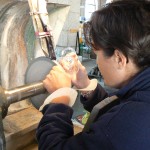
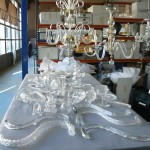
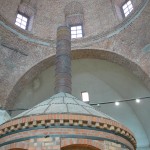
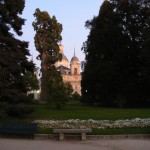
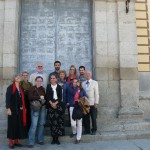
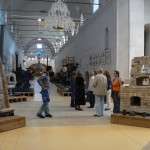
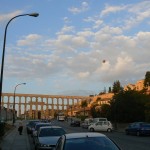
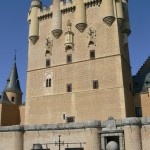
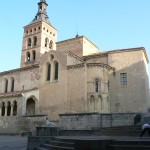
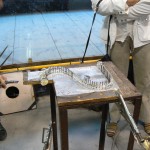
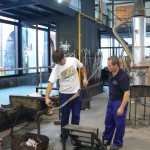
No Comments, Comment or Ping
Reply to “That was our meeting “Light and Glass” in La Granja, Spain September 24th – 27th 2009”